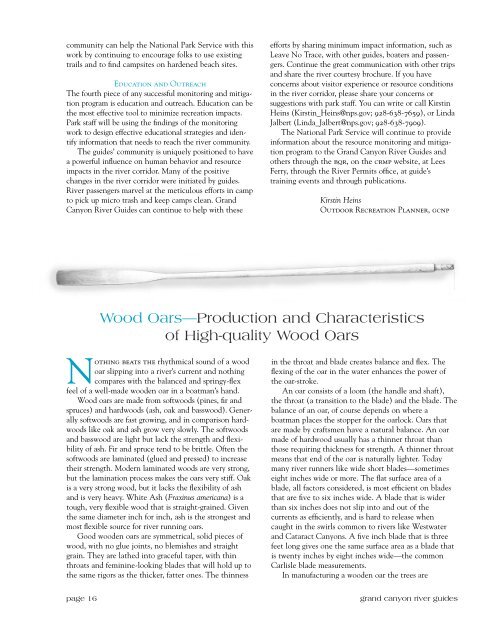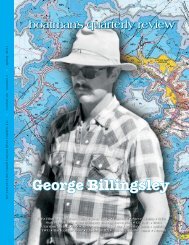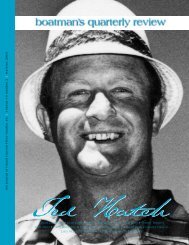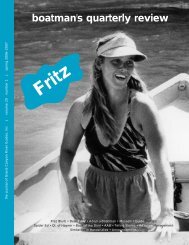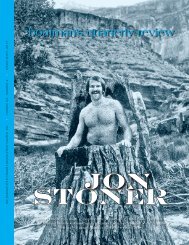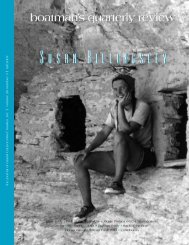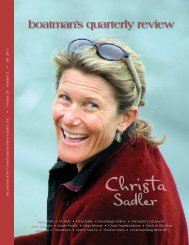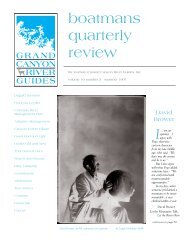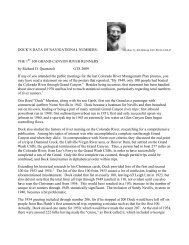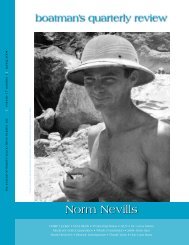winter 07-08 / 20:4 - Grand Canyon River Guides
winter 07-08 / 20:4 - Grand Canyon River Guides
winter 07-08 / 20:4 - Grand Canyon River Guides
You also want an ePaper? Increase the reach of your titles
YUMPU automatically turns print PDFs into web optimized ePapers that Google loves.
community can help the National Park Service with this<br />
work by continuing to encourage folks to use existing<br />
trails and to find campsites on hardened beach sites.<br />
Education and Outreach<br />
The fourth piece of any successful monitoring and mitigation<br />
program is education and outreach. Education can be<br />
the most effective tool to minimize recreation impacts.<br />
Park staff will be using the findings of the monitoring<br />
work to design effective educational strategies and identify<br />
information that needs to reach the river community.<br />
The guides’ community is uniquely positioned to have<br />
a powerful influence on human behavior and resource<br />
impacts in the river corridor. Many of the positive<br />
changes in the river corridor were initiated by guides.<br />
<strong>River</strong> passengers marvel at the meticulous efforts in camp<br />
to pick up micro trash and keep camps clean. <strong>Grand</strong><br />
<strong>Canyon</strong> <strong>River</strong> <strong>Guides</strong> can continue to help with these<br />
efforts by sharing minimum impact information, such as<br />
Leave No Trace, with other guides, boaters and passengers.<br />
Continue the great communication with other trips<br />
and share the river courtesy brochure. If you have<br />
concerns about visitor experience or resource conditions<br />
in the river corridor, please share your concerns or<br />
suggestions with park staff. You can write or call Kirstin<br />
Heins (Kirstin_Heins@nps.gov; 928-638-7659), or Linda<br />
Jalbert (Linda_Jalbert@nps.gov; 928-638-7909).<br />
The National Park Service will continue to provide<br />
information about the resource monitoring and mitigation<br />
program to the <strong>Grand</strong> <strong>Canyon</strong> <strong>River</strong> <strong>Guides</strong> and<br />
others through the bqr, on the crmp website, at Lees<br />
Ferry, through the <strong>River</strong> Permits office, at guide’s<br />
training events and through publications.<br />
Kirstin Heins<br />
Outdoor Recreation Planner, gcnp<br />
Wood Oars—Production and Characteristics<br />
of High-quality Wood Oars<br />
Nothing beats the rhythmical sound of a wood<br />
oar slipping into a river’s current and nothing<br />
compares with the balanced and springy-flex<br />
feel of a well-made wooden oar in a boatman’s hand.<br />
Wood oars are made from softwoods (pines, fir and<br />
spruces) and hardwoods (ash, oak and basswood). Generally<br />
softwoods are fast growing, and in comparison hardwoods<br />
like oak and ash grow very slowly. The softwoods<br />
and basswood are light but lack the strength and flexibility<br />
of ash. Fir and spruce tend to be brittle. Often the<br />
softwoods are laminated (glued and pressed) to increase<br />
their strength. Modern laminated woods are very strong,<br />
but the lamination process makes the oars very stiff. Oak<br />
is a very strong wood, but it lacks the flexibility of ash<br />
and is very heavy. White Ash (Fraxinus americana) is a<br />
tough, very flexible wood that is straight-grained. Given<br />
the same diameter inch for inch, ash is the strongest and<br />
most flexible source for river running oars.<br />
Good wooden oars are symmetrical, solid pieces of<br />
wood, with no glue joints, no blemishes and straight<br />
grain. They are lathed into graceful taper, with thin<br />
throats and feminine-looking blades that will hold up to<br />
the same rigors as the thicker, fatter ones. The thinness<br />
in the throat and blade creates balance and flex. The<br />
flexing of the oar in the water enhances the power of<br />
the oar-stroke.<br />
An oar consists of a loom (the handle and shaft),<br />
the throat (a transition to the blade) and the blade. The<br />
balance of an oar, of course depends on where a<br />
boatman places the stopper for the oarlock. Oars that<br />
are made by craftsmen have a natural balance. An oar<br />
made of hardwood usually has a thinner throat than<br />
those requiring thickness for strength. A thinner throat<br />
means that end of the oar is naturally lighter. Today<br />
many river runners like wide short blades—sometimes<br />
eight inches wide or more. The flat surface area of a<br />
blade, all factors considered, is most efficient on blades<br />
that are five to six inches wide. A blade that is wider<br />
than six inches does not slip into and out of the<br />
currents as efficiently, and is hard to release when<br />
caught in the swirls common to rivers like Westwater<br />
and Cataract <strong>Canyon</strong>s. A five inch blade that is three<br />
feet long gives one the same surface area as a blade that<br />
is twenty inches by eight inches wide—the common<br />
Carlisle blade measurements.<br />
In manufacturing a wooden oar the trees are<br />
page 16<br />
grand canyon river guides


